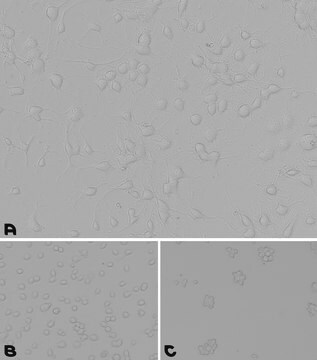A-005-M
Poly-ʟ-Lysine Hydrobromide
synthetic, liquid, 0.1 mg/mL, suitable for cell culture
Sinónimos:
Lysine
About This Item
Productos recomendados
product name
Poly-L-Lysine Solution, 0.01%
needle size
2.0 mm
Quality Level
sterility
sterile
form
liquid
mol wt
Mw 84000 Da
manufacturer/tradename
NovaSeptum®
concentration
0.01 % (w/v)
0.1 mg/mL
technique(s)
cell attachment: suitable
cell culture | mammalian: suitable
shipped in
dry ice
storage temp.
−20°C
General description
The molecular weight of Poly-L-Lysine for cell culture can vary significantly, with lower molecular weight (30,000 Da) being less viscous and higher molecular weight (greater than 300,000 Da) having more binding sites per molecule. This product uses a Poly-L-Lysine of 84000 Da, yielding a solution viscosity for easy handling while providing sufficient binding sites for cell attachment.
Application
Biochem/physiol Actions
Quality
Preparation Note
1. Thaw Poly-L-Lysine solution at room temperature.
2. Dilute Poly-L-Lysine solution to the desired concentration in sterile water.
3. Fully coat the cell culture surface with diluted Poly-L-Lysine solution. Use 5 mL volume for 6-cm plates and 10 mL volume for 10-cm plates and T75 flasks.
4. Allow the cell culture vessel to sit at room temperature overnight.
5. Aspirate the Poly-L-Lysine solution the following day and rinse the vessel with sterile water followed by coating with desired ECM protein.
Legal Information
Storage Class
12 - Non Combustible Liquids
wgk_germany
WGK 1
flash_point_f
Not applicable
flash_point_c
Not applicable
Certificados de análisis (COA)
Busque Certificados de análisis (COA) introduciendo el número de lote del producto. Los números de lote se encuentran en la etiqueta del producto después de las palabras «Lot» o «Batch»
¿Ya tiene este producto?
Encuentre la documentación para los productos que ha comprado recientemente en la Biblioteca de documentos.
Los clientes también vieron
Artículos
Extracellular matrix proteins such as laminin, collagen, and fibronectin can be used as cell attachment substrates in cell culture.
Nuestro equipo de científicos tiene experiencia en todas las áreas de investigación: Ciencias de la vida, Ciencia de los materiales, Síntesis química, Cromatografía, Analítica y muchas otras.
Póngase en contacto con el Servicio técnico









